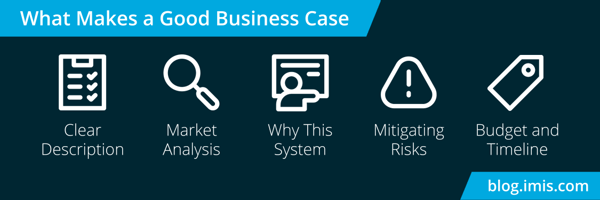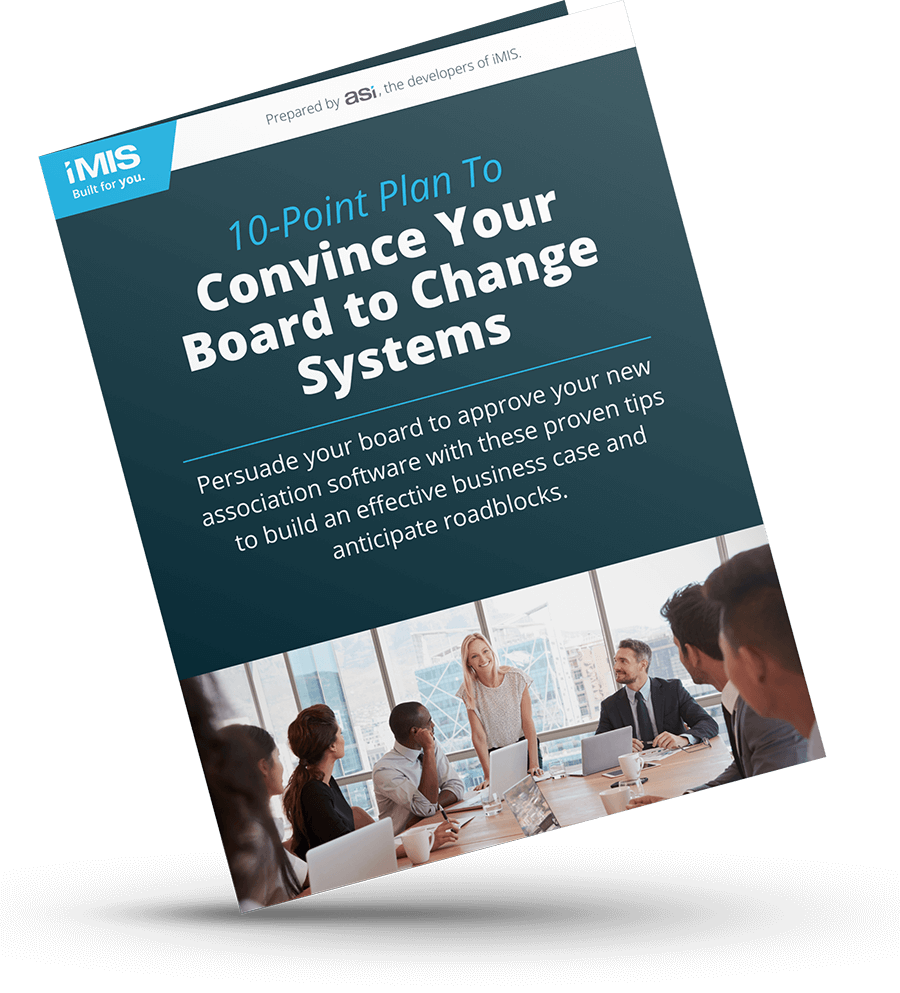So you’ve gone through the process of finding a new member management system and now there’s just one more step to take: getting Board approval for the project. For many association professionals, this is the scariest part.
We’ve got you covered with the following 10-point plan (and a helpful downloadable resource) to get your Board on board (pun intended) so you can sail through the approval process.
10-Point Plan to Convince Your Board to Change Systems
1. Get Your CEO on Board
No matter how persuasive your presentation may be, the Board will turn to your CEO/Executive Director/President for their recommendation. So, you need to ensure your executive is absolutely behind the project. Depending on the size and structure of your organization, your exec may be part of the system Selection Committee. If they’re not, as the Selection Committee Lead, it’s your responsibility to keep the CEO up-to-speed on what’s happening and demonstrate how the initiative will positively impact your organization.

2. Understand the Board Structure
For member-centric organizations, the “Board” can mean different things. You’ll need to understand exactly which body will vote on your project and work with your CEO to prepare accordingly. The decision-making Board is often composed of the chairpersons of key subcommittees (such as Finance, Technology, Operations, Policy, HR, etc.) so it will be important to ensure your corresponding subcommittee chairperson is unequivocally behind the new system initiative.
Win over your Technology Subcommittee chairperson if you have one. Next to your CEO, this is the person they will likely turn to for a recommendation.

3. Start EARLY
No Board member likes a surprise. To win approval for your new association software, you’ll need to tell them that you’re initiating the project and then provide progress updates at nearly EVERY Board meeting. These updates don’t need to be long; you just want to keep them apprised of what’s happening and the next steps you’ll be taking. They want to be a part of the decision-making process without getting into the weeds. By setting the stage, planting seeds, and keeping them informed, the approval process should be much smoother.
Your CEO is key to this process; check out this helpful article from ASAE: Sharpen Your Board Management Skills
4. Build a Business Case
Yes, it sounds like more homework but it’s worth it. Your Board is likely made up of attorneys, financial professionals, industry experts, etc. who typically look at the bottom line. They want to make sure they’re providing good stewardship; a business case will demonstrate why you’re recommending the new system and how the benefits far outweigh the costs.
A business case:
- Puts everyone on the same page
- Ensures important issues are covered
- Demonstrates the ROI

There are many approaches you can take, but your business case should:
- Provide a clear description of the business problem you’re trying to solve
- Include an analysis of the marketplace
- Describe the system you’ve chosen and why
- Outline potential risks and how you’ll mitigate them
- Summarize budget details and the estimated timeline
Here are a few resources you can use:
How To Write a Concise Business Case (With Template) from Indeed
The Right Way to Present Your Business Case from Harvard Business Review
5. Demonstrate the Risk of Doing Nothing
If there’s any doubt in their minds, Board members will often choose to kick the can down the road until they’re certain. As you update them about your progress, you’ll also want to point out the risk of doing nothing. Going through your association software search, you have undoubtedly identified risks to the organization if you continue with the status quo, such as:
- Inability to process renewals on a timely basis
- Inaccurate invoices
- Slower member servicing times
- Decreased member engagement
Your Board can only mitigate the risks they know about. Let them know how the organization and members are being affected by your outdated system right now.
Your Board members may not be tech-savvy. Spell out any acronyms and explain concepts in plain language without a lot of jargon.
6. Do the Due Diligence
Summarize the solutions you reviewed and why you rejected them. Try to speak in measurable terms (efficiency, staff time required, ROI, Total Cost of Ownership, etc.) — you want to be able to quantify the impact. You should give them bullet points that make them feel confident you’ve responsibly reviewed the options and determined they were not right for you — and why the solution you’re presenting is the optimal choice.
7. Prepare Your Rebuttals in Advance
Workshop a possible response to each objection you may encounter and practice your rebuttals ahead of time so they come naturally. Typical issues may be:
- It’s too expensive
- The timing isn’t right
- We don’t need all these features — let’s keep it simple
- Installing a new system is just too time-consuming/a burden on staff
- How do you know this system will be any better than the last one?
8. Profile Your Board Members
Your Board members are people, too — they’ve got their own interests, experiences, and even biases. It’s important to know as much as you can about each one beforehand. Consider:
- Consulting with your CEO and developing a strategy to ensure each Board member’s likely concerns will be addressed in your presentation
- Reading their bios and posts on LinkedIn
- Checking their other social media accounts for more clues about their interests
9. Count the Votes Before You Enter the Room
Working with your CEO, you should know how each voting Board member feels about your initiative ahead of time. If you don’t think you have the support for the initiative yet, don’t present. It’s also important to make sure there’s no other big-ticket project up for Board approval at the same meeting that could inadvertently draw attention — and budget dollars — away from the new system.
Practice the presentation with the Technology Subcommittee chair and your selection committee. Ask them to identify holes in your argument and ways you can make the presentation more persuasive. They need to be hard on you; it’s better to hear the objections when you still have time to prepare for them.

10. Lean on Your Solution Provider
Your solution provider can often provide industry stats, success stories, sample business cases, and proven best practice advice you can share in your presentation. They’ve been through this before and can be a tremendously valuable resource.


